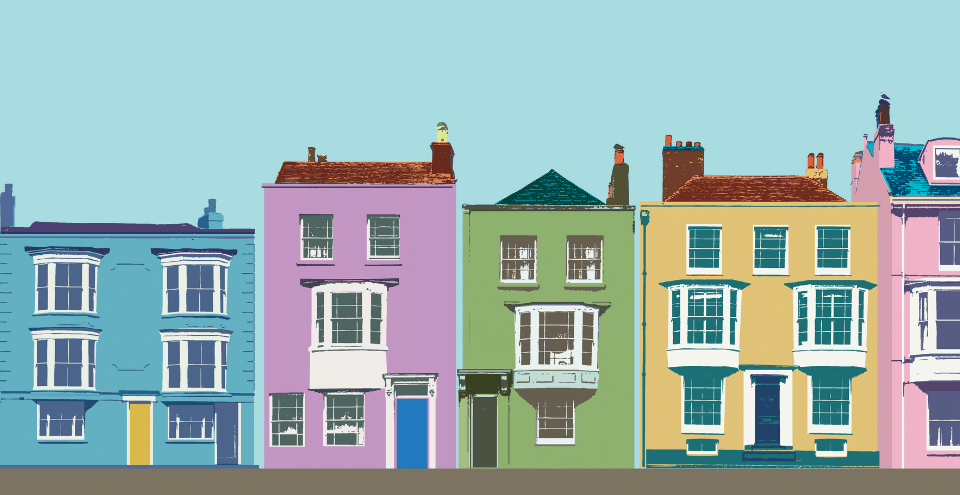Latest News

Damp, condensation and mould – advice for landlords
Jun 19 2024
Our partners at Cornwall Residential Landlords Association have kindly provided this advice for landlords, when dealing with damp, condensation and mould in rental properties.
Damp, condensation and mould is a common problem in homes, with older properties tending to suffer more than new ones, but rental properties are particularly prone. The problem is often a matter of degree: from a small patch of mould or discoloured wallpaper behind the wardrobe, in the very top corner of a bedroom, to serious amounts of mould growth across walls, inside wardrobes and on clothes, furnishings, carpets.
MOULD
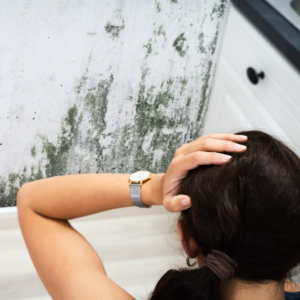 Mould is a serious problem for both landlord and tenant, and is a serious problem because of the health risks associated with mould spores. The mould fungi have been identified as the source of many health problems, including infections, asthma, allergies and sinusitis. Moulds produce allergens, irritants, and in some cases, toxins that may cause reactions in humans. The problem is complex and insidious, and is a particular worry to landlords because of potential legal claims. Legal cases are seldom straightforward and liability has just as often fallen on the tenants as on landlords. Causes of mould growth from straightforward building defects are, without doubt, the landlord’s responsibility in a residential property.
Mould is a serious problem for both landlord and tenant, and is a serious problem because of the health risks associated with mould spores. The mould fungi have been identified as the source of many health problems, including infections, asthma, allergies and sinusitis. Moulds produce allergens, irritants, and in some cases, toxins that may cause reactions in humans. The problem is complex and insidious, and is a particular worry to landlords because of potential legal claims. Legal cases are seldom straightforward and liability has just as often fallen on the tenants as on landlords. Causes of mould growth from straightforward building defects are, without doubt, the landlord’s responsibility in a residential property.
The true cause of condensation-based mould growth is often complex and a combination of things. It is sometimes caused by inadequacies in the building, but very often the main cause of mould growth is the lifestyle of the tenants. In addition to this, with lifestyle causes, once the mould growth has been allowed to take hold at some point in the history of the property, say with a tenant who lived with inadequate heating and ventilation, and produced excessive amounts of moisture (steam) through cooking, washing, internal drying, etc, it can reoccur again and again, even years later, once the conditions are allowed to deteriorate again, without the property having undergone thorough eradication treatment, the mould can quickly re-appear. In other words, the mould spores can lay dormant when the conditions are against them, but will be reinvigorated once cold, damp moisture laden conditions are allowed to reappear. Older properties, especially those with solid walls (no cavity and no cavity wall insulation) are more prone to condensation problems. It is not incumbent on the landlord to bring an old property up to modern standards, but merely to show that all reasonable precautions have been taken. This may include educating the tenants as to how to avoid creating condensation conditions.
The main causes of mould:
- Water leaks from windows, roof, downspouts, guttering, internal plumbing and flooding
- Penetrating damp through walls
- Rising damp – usually caused by non-existent or defective damp proof courses
- Wet or damp crawl spaces
- Condensation from high relative humidity in air
- Too much water vapour or steam being generated through cooking, washing, bathing, showering and clothes drying which is allowed to travel throughout the house
- Inadequate ventilation
- Inadequate heating
- Inadequate cleaning and drying after major water leaks and bursts or floods.
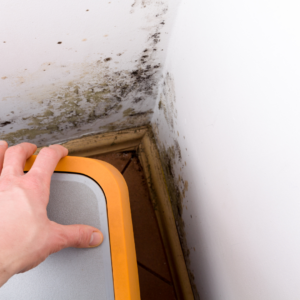 Mould from water leaks, penetrating and rising damp typically appears in the house and in crawl spaces:
Mould from water leaks, penetrating and rising damp typically appears in the house and in crawl spaces:
- Walls under the bottom corners of windows
- Floors around toilets and under dishwashers
- Walls around uninsulated cold-water pipes
- Around the chimney in the attic
- Near damaged or blocked downspouts
- Basement – Bottom of walls, corners and floors
- Bottoms of walls – bridged or earth covered damp proof courses
- Exposed soil
- Standing water
- Mould growth on the joists or subfloor
- Wood debris on ground
- Under boxes or carpets
- Cracks and holes
- Efflorescence (A mineral deposit which is a sign of moisture entering the home)
Mould from condensation typically appears in:
Bathrooms
- Evidence of mould growth? How long does it take for moisture to disappear off cold surfaces after baths and showers?
- Is there an extractor fan and is it used?
- on ceilings over the bath or shower
- window glass, sills and frames
- under or behind the toilet and tank
- exterior walls and tiled surfaces
Bedrooms
- windows, in the bottom corners, sides or on the glass
- behind dressers and wardrobes on exterior walls
- particularly on the top corners of the bedroom walls which are the furthest from any heating source
Crawl spaces
- on dry wall attached to exterior walls
- bottom of uninsulated wood floors
- inside of foundation walls or skirting
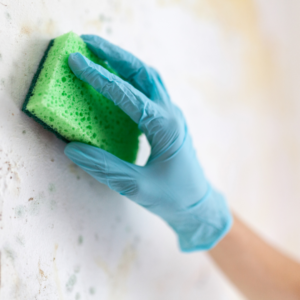
Preventing black mould – hints and tips
- NEVER use cheap bleach cleaning sprays, these all contain salts which makes the mould return.
- Mould grows in cold rooms on external walls, keep these rooms and walls free from cupboards, bed headboards, furniture so that these areas can ventilate.
- If the weather is mild, try to open windows for as long as possible. This helps to kill mould off and is healthier.
- Keep wardrobes uncluttered, leave a wardrobe door open, allow air to get inside the to stop mould growing on clothes, shoes and boxes.
- Wall and windows that get wet from condensation should be dried down every day with a dry cloth, if the moisture is dried up the mould spores cannot grow.
- Dehumidifiers are very expensive to run, it is cheaper to use what ventilation is available through windows.
- When cooking or showering keep these doors closed to reduce stea travelling throughout the property, keep these doors closed all the time and ideally, if these rooms have windows leave them open for a while.
- When cleaning mould keep the door to that room closed. Open a window before starting to clean. Use a clean kitchen cloth and make it damp with warm water and with a dash of basic washing up liquid. Wipe down the affected area, repeat if very bad growth. Dry down with a clean dry cloth. Keep the door closed and window open to help drying down.
- Cleaning mould is the time spores become active, wear a mask and keep infants out of the room while cleaning.
- Do not let black mould get out of control. Speak to your managing agent or landlord if you have concerns but if you do these measures regularly it will help you a great deal and it does not cost a lot of money
CONDENSATION
What is Condensation?
Condensation occurs where moist warm air comes into contact with colder dryer air, or a surface, which is at a lower temperature. Air contains water vapour in varying quantities; its capacity to do so is related to its temperature – warm air holds more moisture than cold air. When moist air comes into contact with either colder air or a colder surface, the air is unable to retain the same amount of moisture and the water is released to form condensation in the air or on the surface. Condensation is generally noticeable where it forms on non-absorbent surfaces (i.e. windows, window sills, mirrors or tiles) but it can form on any surface and it may not be noticed until mould growth or rotting of material occurs
Keeping the moist air in the house through effective draft proofing aggravates the effect of moisture generation. It is theoretically possible to avoid condensation altogether by adequately venting moist air from the room in which it is generated. In certain areas of a house (such as bathrooms and kitchens) the warm air contains a lot of moisture; if that air then spreads to cooler parts of the house it condenses on any colder surface. Ventilation is only effective if it is consistent throughout the whole envelope of the house. Condensation is encouraged by poor air circulation where stagnant air pockets form (behind furniture and in cupboards) and the first evidence is often the appearance of mould growth and a musty smell on clothes in wardrobes. The warm moist air rises to the highest points in the building, forming condensation in those areas, which are often coldest, including bedrooms, wardrobes and upstairs bathrooms and toilets, etc. The modern lifestyle, and particularly that of tenants, means that many houses remain unoccupied and unheated throughout the greater part of the day, allowing the fabric of the building to cool right down. The moisture-producing activities are then concentrated into a relatively short time period, producing large amounts of steam when the building structure is still relatively cold.
Interstitial condensation occurs where, after prolonged periods of exposure to excess moisture content in the air, usually coupled with cold damp conditions, moisture is diffused deeply into the fabric of the building. The wallpaper, plaster, mortar, masonry and timber gradually absorb more and more moisture. This will lead to a vicious circle of colder surfaces, increased mould, deterioration of the building materials, wet and dry rot in timber and electrical system problems.
 Controlling Condensation
Controlling Condensation
Check the structure of the building first for obvious defects:
- Check that the walls are not suffering from rising damp.
- Ensure that there is an effective damp proof course, that it is not bridged or damaged. A new damp course can installed by removing one brick at a time and inserting a physical DPC, or a chemical DPC can be injected into existing walls.
- The damp proof course should be at least 6 inches above any outside paving to avoid heavy rain from bouncing back up and soaking the brickwork above the DPC – consider lowering the paving around the house where necessary.
- Check that any wall cavities are clear of rubble, debris can accumulate over the years – to remove it normally requires removal of bricks at each corner and racking the cavity clean. Where the dampness is restricted to one area and no other reason can be identified, it is a relatively easy task to check/clean inside the cavity.
- Check that all airbricks are clear and consider fitting additional airbricks to ventilate under suspended floors. Modern practice is to fit a duct across the cavity so that the cavity itself is not ventilated.
- Consider applying a surface finish to outside walls. Either a clear waterproofing finish (silicone) which can be brushed on or a paint/textured finish, which will cause most of the rain to run down (check that you are allowed to change the outside appearance of your house before you start doing so). Evaporating water from the outside of walls can remove heat from the wall making it considerably colder.
- Check the roof to make sure that it is sound and directing rain into the guttering, not into the structure of the building.
- Check the guttering and down pipes, make sure that they are carrying the water away and that there are no damaged/blocked gutters or drainpipes causing the external wall to become soaking wet.
- Check solid floors to ensure that they are dry and free from condensation. If not they may need a damp proof membrane and insulation below – potentially a big job.
- Check that there are no leaking water tanks or pipes within the house.
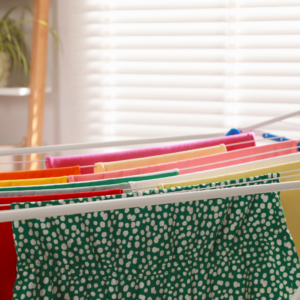 Once you are happy with the structure of the building, look to the occupation lifestyle. You may need to educate your tenants as to how to avoid condensation, such as:
Once you are happy with the structure of the building, look to the occupation lifestyle. You may need to educate your tenants as to how to avoid condensation, such as:
- After a bath or shower, the room should be ventilated to the outside, not to the rest of the house – just opening a window (and closing the door) will help. Fit an extractor fan.
- Dry clothes out of doors or in a cool area of the premises – this latter suggestion may sound strange, it will take longer but less moisture will be held in the air at any one time.
- While drying clothes indoors, ventilate the room. Dryers should have external air extraction.
- When people come in with wet coats, they should be hung outside the living space to dry. A good reason for a porch.
- Try to increase the rate of change of air in the premises – increase ventilation. Add forced ventilation/extraction to areas which produce a lot of moisture (kitchen, bathroom). Extractor fans are available with an air-moisture switch so that they operate automatically while the moisture in the air is above a set amount. Other units (more expensive/ complicated) are available which remove the moist air but reuse the thermal energy that would otherwise be wasted.
- Consider changing the fuel you use. Electric is the driest, paraffin probably the wettest.
- Consider using a dehumidifier – domestic types are now available and can remove a surprising amount of water from the air.
Condensation will almost always occur with single glazed windows. The inside surfaces of these windows can be almost the same as the outside temperature. Overnight in winter their temperature can drop below freezing and often the inside windowsill will be awash first thing in the morning. Simple secondary glazing consisting of little more than a sheet of glass (or plastic) screwed to the window frame with a seal in between can be fitted. Alternatively new double-glazing windows can be considered. Although much more expensive than simple secondary glazing, there are additional benefits: existing wooden or metal windows will need continuous maintenance and repair whereas new double glazed units are low maintenance.
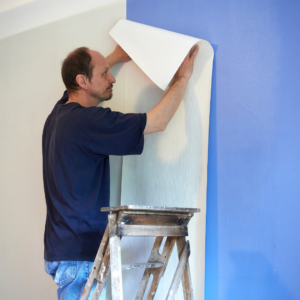 Some decorative materials always have cold surfaces, (i.e. ceramic tiles, mirrors etc.) and are well known for the formation of condensation. Unfortunately we tend to use tiles in the kitchen and bathroom, two rooms where high humidity is likely. There is not much you can do where this occurs other than keeping the room (and the tiles) evenly heated or improve by ventilation.
Some decorative materials always have cold surfaces, (i.e. ceramic tiles, mirrors etc.) and are well known for the formation of condensation. Unfortunately we tend to use tiles in the kitchen and bathroom, two rooms where high humidity is likely. There is not much you can do where this occurs other than keeping the room (and the tiles) evenly heated or improve by ventilation.- Some wall surfaces can also be a problem. Where the wall is papered the situation may be made worse if there are many layers of paper, (this can act like blotting paper) so strip off all the layers and re-paper the wall.
- Things can also be improved by lining the wall with thin expanded polystyrene (normally available from your wallpaper stockist) before you hang new wallpaper.
- Painted walls have a cold surface. If you do not want to paper it, consider lining it with wooden panelling or another material such as cork tiles.
- Alternatively a wall can be insulated by fitting a false wall with a layer of insulation behind and the front either being panelled or plasterboard so that the new surface can be papered. However, remember that with all these ‘covering up’ methods, they possibly just hide and do not cure the problem – in fact they may make things worse by encouraging stagnant air and mould spore growth.
Try to get to the cause
- In properties with cavities, the installation of cavity wall insulation will keep the house considerably warmer and will help prevent condensation.
- Ceilings under the roof should not suffer too much from condensation providing adequate roof insulation is fitted.
- Where ceilings have a high gloss finish, consider covering with cork or fibre tiles; alternatively wooden panelling can be installed.
- Solid floors (i.e. a slab of concrete) are often cold because of their large thermal mass (they take a long time to warm up). Even vinyl floor tiles tend to be cold, however there are a number of ‘warm’ flooring materials available such as cork or cushion tiles. Thin wood flooring can be fitted on most existing solid floors.
Removal of mould and cleaning up after water leaks and floods
It is very important to clean up and dry-out the property immediately after water damage caused by flooding, water leaks and condensation, before mould spores have a chance to accumulate and grow.
- Identify and eradicate any sources of moisture.
- Completely remove and dispose of mould contaminated materials.
- Find any mould on porous items that may have absorbed moisture. In particular, if you see evidence of mould on any porous surfaces such as insulation, plaster, carpeting and other floor coverings, ceiling tiles, wood, clothing and textiles, furniture and furnishings, and paper, these items should be bagged in plastic and removed. Porous materials that may have been in contact with sewage should also be bagged and removed. Non-porous materials can be saved if they are properly cleaned and dried.
Dry out all materials that are wet
 Do this as soon as you possibly can. These should be dried or removed from the building if possible.
Do this as soon as you possibly can. These should be dried or removed from the building if possible.- For severe moisture problems, use space heaters and dehumidifiers and move wet items away from walls and off floors. Do not operate fans if visible mould is already present.
Cleaning non-porous or semi-porous items
It is possible for mould to grow on hard materials like plastic, concrete, glass, or metal, but this can usually be removed with careful cleaning. Solid wood items can also be salvaged through cleaning, if they are structurally sound.
- For heavily contaminated items, begin by using a high suction industrial vacuum cleaner (not a conventional household vacuum) to remove as much contamination as possible.
- Carefully damp-wipe the items, to remove as much surface contamination as possible. Rinse wipes often with clean water. Dispose of your wipes and rinse water frequently.
- Thoroughly scrub all contaminated surfaces. Use a stiff brush, hot water, and a non-ammonia soap/ detergent or commercial cleaner.
- Collect excess cleaner and cleaning water using a wet/dry vacuum cleaner, a mop or sponge.
- Finally, rinse the surface or items and then clean-up the whole area with clean water. Collect and fully dispose of the excess rinse water, and dry everything out as quickly as possible.
Disinfect surfaces
- Disinfection should not be a substitute for cleaning. However, it is essential for items that have been in contact with sewage. If you disinfect, follow these guidelines:
- Use 1/4 to 1/2 cup of bleach per gallon of water and apply to surfaces, you can apply with a spray, sponge, or some other suitable method.
- Collect any excess bleach solution with a wet/dry vacuum cleaner, sponge or mop but do not rinse or wipe the bleach solution from the items or surfaces being treated — allow it to dry on the surface.
Protecting yourself
- Use rubber gloves
- Use eye goggles that seal out fine dust.
- Wear disposable overalls.
- Wear a medium to high-efficiency filter dust mask.
- Do not eat, drink or smoke in the contaminated area, since disease-causing organisms from mould spores, sewage or floodwater may be present. People with existing health problems or those very sensitive to mould should not do clean-up work in situations where there is heavy mould growth. It may be prudent to consider using professionals to do the clean-up work for you if you have any doubts about safety of the effectiveness of your work.
For more advice and support, please contact our Landlord Liaison Officer on landlords@cep.org.uk or 0800 954 1956

